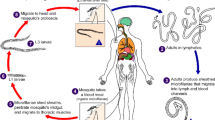Abstract
This manuscript considers the transmission dynamics of lymphatic filariasis with some intervention strategies in place. Unlike previously developed models, our model takes into account both the exposed and infected classes in both the human and mosquito populations, respectively. We also consider vaccinated, treated and recovered humans in the presented model. The global dynamics of the proposed model are completely determined by the basic (\({\mathcal {R}}_0\)) and effective reproduction numbers (\({\mathcal {R}}_e\)). We then use Lyapunov function theory to find the sufficient conditions for global stability of both the disease-free equilibrium and endemic equilibrium. The Lyapunov functions show that when the basic reproduction number is less than or equal to unity, the disease-free equilibrium is globally asymptotically stable, and when it is greater than unity then the endemic equilibrium is also globally asymptotically stable. Finally, numerical simulations are carried out to investigate the effects of the intervention strategies and key parameters to the spread of lymphatic filariasis. The numerical simulations support the analytical results and illustrate possible model behavioral scenarios.








Similar content being viewed by others
References
Allen LJS (2007) An introduction to mathematical biology. Pearson Education Ltd, New York
Anderson RM, May RM (1992) Infectious disease of humans: dynamics and control. Oxford University Press, London
Behm CA, Bending MM, McCarter JP, Sluder AE (2003) WHO/TDR scientific working group on RNA interference as a means of identifying drug targets for filariasis’ report. WHO report. http://www.who.int/tdr/publications/documents/rna-drug.pdf
Bhunu CP, Mushayabasa S (2012) Transmission dynamics of lymphatic filariasis. ISRN Biomath 2012(930130):1–9
CDC (2013) Lymphatic filariasis. http://www.cdc.gov/parasites/lymphaticfilariasis/treatment.html. Accessed 21 Aug 2015
Center Carter (2015) Lymphatic filariasis elimination program. https://www.cartercenter.org/health/lf/index.html. Accessed 6 May 2015
Chan MS, Srividya A, Norman RA, Pani SP, Ramaiah KD, Vanamail P, Michael E, Das PK, Bundy DAP (1994) EPIFIL: a dynamic model of infection and disease in lymphatic filariasis. Am J Trop Med Hyg 59(4):606–614
Chitnis N, Hyman JM, Cushing JM (2008) Determining important parameters in the spread of malaria through the sensitivity analysis of a mathematical model. Bull Math Biol 70:1272–1296
End Fund (2015) Lymphatic filariasis. Ending neglected disease.https://end.org/ntds-in-focus/lymphatic-filariasis/. Accessed 6 May 2015
Khan Y (2009) An effective modification of the Laplace decomposition method for nonlinear equations. Nonlinear Sci Numer Simult 10:1373–1376
Labadin J, Kon CML, Juan SES (2009) Deterministic malaria transmission model with acquired immunity. In: Proceedings of world congress on engineering and computer science
LaSalle JP (1976) The stability of dynamic systems. SIAM, Philadelphia
Lashari AA, Zaman G (2011) Global dynamics of vector-borne diseases with horizontal transmission in host population. Comput Math Appl 61(4):745–754
Luz PM, Struchiner CJ, Galvani AP (2010) Modeling transmission dynamics and control of vector-borne neglected tropical diseases. PLoS Negl Trop Dis 4(10):e761
Makinde OD (2007) Adomian decomposition approach to SIR epidemic model with constant vaccination strategy. Appl Math Comput 184:842–848
Michael E, Malecela-Lazaro MN, Simonsen PE, Pedersen EM, Barker G, Kumar A, Kazura JW (2004) Mathematical modeling and the control of lymphatic filariasis. LANCET Infect Dis 4(4):223–234
Mtisi E, Rwezaura H, Tchuenche JM (2009) A mathematical analysis of malaria tuberculosis co-dynamics. Discr Cont Dyn Syst Series B 12(4):827–864
Mwamtobe PM, Abelman S, Tchuenche JM, Kasambara A (2014) Optimal (control of) intervention strategies for malaria epidemic in Karonga District, Malawi. Abst Appl Anal 2014(594256):1–20
Mwamtobe PM, Simelane SM, Abelman S, Tchuenche JM (2017) Mathematical analysis of a lymphatic filariasis model with quarantine and treatment. BMC Public Health 17:265. https://doi.org/10.1186/s12889-017-4160-8
Mwamtobe PM, Simelane SM, Abelman S, Tchuenche JM (2018) Optimal control of intervention strategies in malaria-tubercolosis co-infection with relapse. Biomathematics 11(2):1850017
Norman RA, Chan MS, Srividya A, Pani SP, Ramaiah KD, Vanamail P, Michael E, Das PK, Bundy DAP (2000) EPIFIL: the development of an age-structured model for describing the transmission dynamics and control of lymphatic filariasis. Epidemiol Infect 124(3):529–541
Okosun KO, Ouifki R, Marcus N (2011) Optimal control analysis of a malaria disease transmission model that includes treatment and vaccination with waning immunity. Biosystems 106(2–3):136–145
Ottesen EA, Duke BOL, Behbehani K (1997) Strategies and tolls for the control/elimination of the lymphatic filariasis. Bull WHO 75(6):491–503
Supriantna AK, Anggriani N (2012) Lymphatic filariasis transmission and control: a mathematical modelling approach. In: In: Alfonso JR-M, ed. Book chapter in Current Tropics in Tropical Medicine, pp 425–442, ISBN: 978-953-51-0274-8
Swaminathan S, Pan SP, Rengachari R, Kaliannagounder K, Pradeep DK (2008) Mathematical models for lymphatic filariasis transmission and control: challenges and prospects. BioMed Central 1(2):1–9
Tasman H, Supali T, Suprianta AK, Nuraini N, Soewono E (2015) A mathematical model for long-term effect of diethylcarbamazine–albendazole mass drug administration on lymphatic filariasis. AIP Conf Proc 1651:138–146
Tewa JJ, Dimi JL, Bowong S (2009) Lyapunov function for dengue disease transmission model. Chaos Solitons Fract 39(2):936–941
van de Driessche P, Watmough J (2002) Reproduction numbers and sub-threshold endemic equilibria for compartmental models of disease transmission. Math Biosci 180:29–48
Wolfram Research, Inc (2012) Mathematica Version 9.0, Champaign
World Health Organization (2015) Lymphatic filariasis. https://www.who.int/lymphatic_filariasis/en/. Accessed May 2015
Acknowledgements
The reviewers are thanked for their careful reading of our manuscript. Their useful comments have resulted in an improved manuscript.
Author information
Authors and Affiliations
Corresponding author
Additional information
Publisher's Note
Springer Nature remains neutral with regard to jurisdictional claims in published maps and institutional affiliations.
This document is a collaborative effort.
Rights and permissions
About this article
Cite this article
Simelane, S.M., Mwamtobe, P.M., Abelman, S. et al. A Mathematical Model for the Transmission Dynamics of Lymphatic Filariasis with Intervention Strategies. Acta Biotheor 68, 297–320 (2020). https://doi.org/10.1007/s10441-019-09370-y
Received:
Accepted:
Published:
Issue Date:
DOI: https://doi.org/10.1007/s10441-019-09370-y




